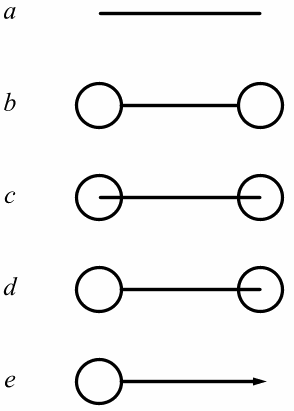Dynamic Design. Dynamizing a line
| Dynamizing a line |
|
The dynamic component of a straight line mostly depends on its ends are formed. An unconnected line (Fig. 8, a) not only has no direction of its own. Only a small fragment of the line near the middle can serve as a guideline for the eye, while at the ends, any movement tends to slow down - we just don't see any reason to keep running along the line as soon as we note that the end of the path has nothing to offer to our perception. |

| Fig. 8: Dynamizing a line by playing with its ends |
|
Our first attempt to accelerate the dynamism of the line by attaching
some objects to its ends (Fig. 8, b) is not too successful.
Not only the line ends now fail to attract the viewer's eyes, but the
static objects that they grow out of seem to suppress any traces of
dynamism remaining in the image. What we see is not a couple of objects
connected by a straight line, but a symmetric and therefore almost
motionless simple figure. Of course, this is only true for this specific
kind of objects attached to a line, and in the next section will discuss how contrasting
objects may be used to generate streams of perception between them.
However, it's more interesting to investigate how two identical
objects can nevertheless generate a strong directed dynamic flow.
This is done by changing the method of attaching the line to an object: from "grows out of" to "jumps into" (Fig. 8, c; even the very prepositions "out of" and "into" used in the previous sentence are dynamic!). Although it's still symmetric and therefore directionless, from the dynamic viewpoint it is a highway compared to the road block of Fig. 8, b. Now it is obvious that the circles do not belong to the same object as the line; they work as separate magnets driving our perception towards the ends of the line. Not surprisingly, Fig. 8, d has the strongest dynamism of all samples studied in this section. Its left end pushes and the right end pulls, resulting in an powerful dynamic flow along the line, from left to right. It is also clear that if the right end simply "hangs in the air" as in Fig 8, e (or if the right circle becomes too large in d) then the dynamic force is pretty much diminished - even if we attempt to keep it up by adding an arrowhead on the loose end. This example is very instructive. Although, as we'll see shortly, contrasting objects are the primary source of dynamism in any composition, even simple and absolutely identical elements - with their added advantage of uniformity and consistency - may induce a strong dynamic flow, if only these objects are properly laid out with regard to their internal dynamic properties. |
Revised: Mar. 16, 1999
URL: https://www.webreference.com/dlab/9903/line.html


 Find a programming school near you
Find a programming school near you